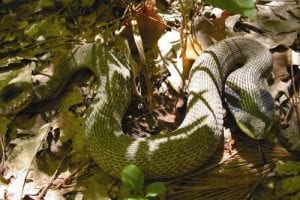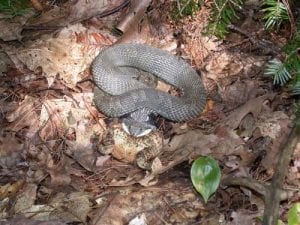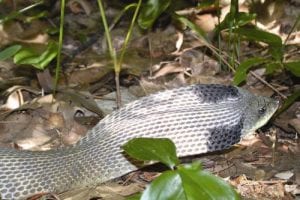Hog-nosed Snake
General Ecology
 The Eastern Hog-nosed snake is recognized as a threatened species in Ontario and has a limited range in Southern Ontario. These snakes are typically found in sandy habitats, such as beaches and dry woods – especially where there is a healthy population of toads which are this snake’s favourite meal! Wasaga Beach Provincial Park provides suitable habitat for this species and has been spotted a number of times within park boundaries.
The Eastern Hog-nosed snake is recognized as a threatened species in Ontario and has a limited range in Southern Ontario. These snakes are typically found in sandy habitats, such as beaches and dry woods – especially where there is a healthy population of toads which are this snake’s favourite meal! Wasaga Beach Provincial Park provides suitable habitat for this species and has been spotted a number of times within park boundaries.
 The name of this snake refers to the expanded scales around the front of their face, giving the snake an up-turned snout appearance. The function of these shovel-like scales is to assist the snake in burrowing through loose sand in search of the American toad. Hog-nosed snakes are specialized toad feeders and are resistant to the toxins toads contain. This snake is not venomous and is harmless.
The name of this snake refers to the expanded scales around the front of their face, giving the snake an up-turned snout appearance. The function of these shovel-like scales is to assist the snake in burrowing through loose sand in search of the American toad. Hog-nosed snakes are specialized toad feeders and are resistant to the toxins toads contain. This snake is not venomous and is harmless.
One of the main threats to the Eastern Hog-nosed snake is the lack of public awareness regarding their fascinating behaviour and their habitat requirements. When threatened, hog-nosed snakes will rear their head, flatten their neck to look like a cobra, and hiss loudly. If this display is not effective, the snake will harmlessly strike at the intruder with its mouth closed. The Eastern Hog-nosed snake has developed these techniques that resemble venomous snake activity as a defence mechanism to ward off predators. As a last resort the snake will finally roll over onto its back and play dead to convince their predator they are an unappetizing feast!
Identification
 Hog-nosed snakes are fairly distinctive. They are a heavy-bodied snake with a shovel-like upturned snout and a grey/brown colour. Young snakes have irregular green and brown patches along their back, while adult snakes tend to be uniform in colour. A key feature of this snake is conspicuous black patches just behind their head. The average length is about 60 cm (2 feet), with a maximum length of one metre (three and a half feet). Often simply observing this behaviour is enough to determine it is a hog-nosed snake!
Hog-nosed snakes are fairly distinctive. They are a heavy-bodied snake with a shovel-like upturned snout and a grey/brown colour. Young snakes have irregular green and brown patches along their back, while adult snakes tend to be uniform in colour. A key feature of this snake is conspicuous black patches just behind their head. The average length is about 60 cm (2 feet), with a maximum length of one metre (three and a half feet). Often simply observing this behaviour is enough to determine it is a hog-nosed snake!
Research
Hog-nosed snake research and monitoring took place in Wasaga Beach from 2001 to 2005 and from 2015 to 2017. This research focused on the life history, microhabitat, and ecological requirements of the Eastern Hog-nosed Snake in Wasaga Beach Provincial Park and the surrounding community. Snakes were captured, measured, and weighed to determine changes over time. Blood samples were also taken to determine relationships within the park’s population and to compare it to other known populations of Hog-nosed snakes. The snakes were only out of their natural setting for a few hours and were released back to the same point of capture.
The other focus of the research was to determine the seasonal movements of these snakes. This was accomplished using radio telemetry equipment. Hog-nosed snakes were surgically implanted with radio transmitters and then tracked every other day until they entered hibernation in the fall. The data from this study helped to assess habitat preferences and what areas of the park they prefer to use for feeding, shedding their skin, mating, and hibernating.
Park Staff continue to report sightings of Hog-nosed snakes, and you can too! Using the Ontario Nature Reptile & Amphibian Atlas app or website, report your sightings of hog-nosed snakes and help us preserve this amazing species!
https://ontarionature.org/programs/citizen-science/reptile-amphibian-atlas/
